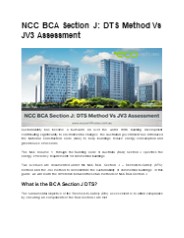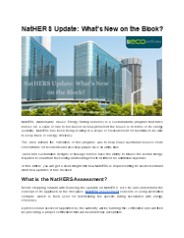Ecocertificates PowerPoint PPT Presentations
All Time
Recommended
The modern performance-based coding solution uses a top-down approach and provides overarching standards. And you or your building experts can demonstrate how the tailored approach fulfils and complies with those standards. You can comply with the BCA Section J using JV3 modelling and conducting the JV3 compliance assessment. In this article, you will learn about the JV3 modelling approach and its benefits.
| PowerPoint PPT presentation | free to download
NABERs, or National Australian Built Environment Rating System, is an agency that believes in scaling the levels of sustainability in building development. This agency works towards ensuring that sustainable buildings shouldn't just be considered for a better planet but also to make the spaces healthier or happier.
| PowerPoint PPT presentation | free to download
If you have plans on developing a new residential building in New South Wales (NSW), you need to obtain a BASIX certificate for you to get approval for the construction. This article forward and give you a clear understanding of what’s BASIX Certificate is and why it is important for the property owners and the environment.
| PowerPoint PPT presentation | free to download
Sustainability has become a buzzword all over the world. With building development contributing significantly to environmental changes, the Australian government has introduced the National Construction Code (NCC) to help buildings reduce energy consumption and greenhouse emissions.
| PowerPoint PPT presentation | free to download
In this article, you will get a clear insight into some of the intricacies associated with indoor environmental quality, its assessment methods, and the core components associated with NABERS.
| PowerPoint PPT presentation | free to download
The Australian Government is requesting feedback on the proposed Sustainable Finance Strategy, and for this, the Commonwealth Treasury issued a "Sustainable Finance Strategy" consultation paper on 2 November 2023. Australian Government has already released many standards and schemes such as NatHERS, BASIX, NABERS, and more to build energy-efficient buildings in the country. This article covers sustainable finance strategy, its benefits, and the reforms required to implement it in Australia.
| PowerPoint PPT presentation | free to download
The aim of this provision is to reduce or target the release of greenhouse gas emissions, mostly resulting from construction activities, all across Australia. This plan or report has been in action since 1997 and has been upgraded with new clauses and rules over time. The NCC BCA, Section J report is meant to summarise and highlight the energy-efficient requirements associated with the construction of a particular building in Australia within the local or national area regulations. In this article, you shall get a clear glimpse at how the upgraded NCC NCA Section J report imposes specific considerations for the property development attributes.
| PowerPoint PPT presentation | free to download
The Australian building standards are introduced to shape the country's environmental footprint and address several climatic changes. With the increasing importance of sustainability worldwide, Australia has established comprehensive regulations, codes, and standards to guide the residents to construct and operate their buildings in an environmentally friendly manner. New Australian homes and significant renovations in Australia must be assessed against the minimum energy performance requirements stated in the building regulations. These standards, codes, and regulations, including NABERS energy, NatHERS, NCC, WERS, and more, serve as the ultimate guide to help improve building sustainability. Let's explore the building sustainability standards you must know before entering 2024.
| PowerPoint PPT presentation | free to download
NatHERs (Nationwide House Energy Rating Scheme) is a sustainability program that rates homes on a scale of one to ten based on how proficient the house is in terms of its energy usability. NatHERs has been trying to bring in a scope of measurement for Australia to be able to keep track of energy efficiency.
| PowerPoint PPT presentation | free to download
A Section J report is prepared to show the adherence of buildings with energy efficiency standards in Section J of the National Construction Code (NCC), which targets minimising greenhouse gas emissions. Class 2-9 buildings are mandated to have the NCC BCA Section J report, with residential class 2 and 4 parts of a building predominantly subjected to BASIX requirements. The primary purpose behind having a Section J report for Australian buildings is to help owners comply with the government’s energy efficiency requirements and make the nation sustainable.
| PowerPoint PPT presentation | free to download
If you are about to construct a property anytime soon in Australia, you might need to be aware of what BASIX is and what some of the sustainability updates on it are for you to adopt. Read along this article till the end to find out!
| PowerPoint PPT presentation | free to download
Looking to assess the energy efficiency of your upcoming residential project? Find a NatHERS Assessor to ensure compliance with energy regulations and optimize your building's environmental performance. Discover qualified professionals proficient in the Nationwide House Energy Rating Scheme (NatHERS) for a sustainable and eco-friendly construction process.
| PowerPoint PPT presentation | free to download
The updated NCC BCA Section J report not only helps promote a greener future but also meets the increasing demand for energy-efficient and environmentally responsible buildings and commercial spaces.
| PowerPoint PPT presentation | free to download
Unlocking NCC BCA's Section J: A Comprehensive Comparison of Section J and JV3 Assessments. Dive into the intricacies of energy efficiency regulations with our detailed guide, 'Section J Vs. JV3 Assessment: Everything You Need to Know.' Explore key insights, differences, and practical implications to navigate these essential building compliance pathways effortlessly.
| PowerPoint PPT presentation | free to download
The National Construction Code (NCC), NatHERS, Green Star Rating System, NABERS, and many other regulations and codes regulate the Australian building industry.
| PowerPoint PPT presentation | free to download
If you're searching for a NABERS Assessor to evaluate your building's energy efficiency, keep an eye out for these 6 essential qualities. Ensuring expertise, certification, experience, client reviews, communication skills, and a commitment to sustainability will lead you to the right NABERS energy professional for your needs.
| PowerPoint PPT presentation | free to download
This article covers tips to make your office building energy efficient with a NABERS rating.
| PowerPoint PPT presentation | free to download
The BASIX Certificate holds pivotal importance in assessing sustainable development. Our concise guide sheds light on the most important aspects of the BASIX Report, offering an insightful exploration of how this certification contributes to promoting environmentally-conscious practices, energy efficiency, and socio-economic progress. Delve into the top facts and findings that underscore the significance of the BASIX Certificate in shaping a greener and more equitable future.
| PowerPoint PPT presentation | free to download
The Australian housing industry is undergoing a transformation towards more sustainable and eco-friendly practices. And the BASIX certificate plays a pivotal role in improving the sustainability and energy efficiency of residential buildings.
| PowerPoint PPT presentation | free to download
The pandemic scenarios have left deep scars on the economy and trade sectors across the globe. Over a prolonged period, the pressing restrictions have been continuing. So, there goes the steadiness to bring slight changes in the ‘new-normal’ atmosphere. Here, the major food industry and business sectors fail to cope up with the eleven-month lockdown.
| PowerPoint PPT presentation | free to download
Title: IPPC Integrated pollution prevention and control Author: Cristina Zani Last modified by: MARCHIORO Created Date: 1/23/2002 9:37:00 AM
| PowerPoint PPT presentation | free to download
GM at leading edge of green car technology in China ... seen no fewer than ten different directors in two years...It (UNESCO) may ...
| PowerPoint PPT presentation | free to view
COMITE DU BOIS - ROME, LE 10/10/2000. ECOCERTIFICATION ET DISTRIBUTION DES PRODUITS BOIS ... LA CHAINE DE CONTROLE Chain of custody. ECOCERTIFICATION ET DISTRIBUTION ...
| PowerPoint PPT presentation | free to view
Flatfish 0.28. Alaska Pollock 0.54. Cod 0.78. Shrimp 1.09. Canned Tuna 1.59 kg ... Flatfish 0.15. NA. Tilapia 0.32 89.3% Crab 0.28 -23.7 ...
| PowerPoint PPT presentation | free to view
School of Business Administration, University of Vermont ... Biocentric Species and other natural things have intrinsic rights to exist and ...
| PowerPoint PPT presentation | free to view
Presentation to the International workshop ' What makes them work? ... FSC conforming to become more palatable to business issues ...
| PowerPoint PPT presentation | free to view
The Australian building sector is one of the strongest pillars supporting the country’s economy. But the same sector is also responsible for creating a staggering amount of pollution.
Do you know that residential buildings in Australia account for around 24% of the country’s energy use and more than 10% of its total carbon emissions? Everyone in Australia desires an energy-efficient home as it’s not only comfortable to live in but also saves a lot on energy bills. These two can be vital factors for prospective homeowners or renters. Even a review of international research discovered that energy-efficient homes usually fetch a higher price. An energy performance rating like the BASIX Certificate is an ideal way to show how energy efficient a home could be. Many countries have mandated that sellers obtain and disclose a home’s rating to potential buyers.




























